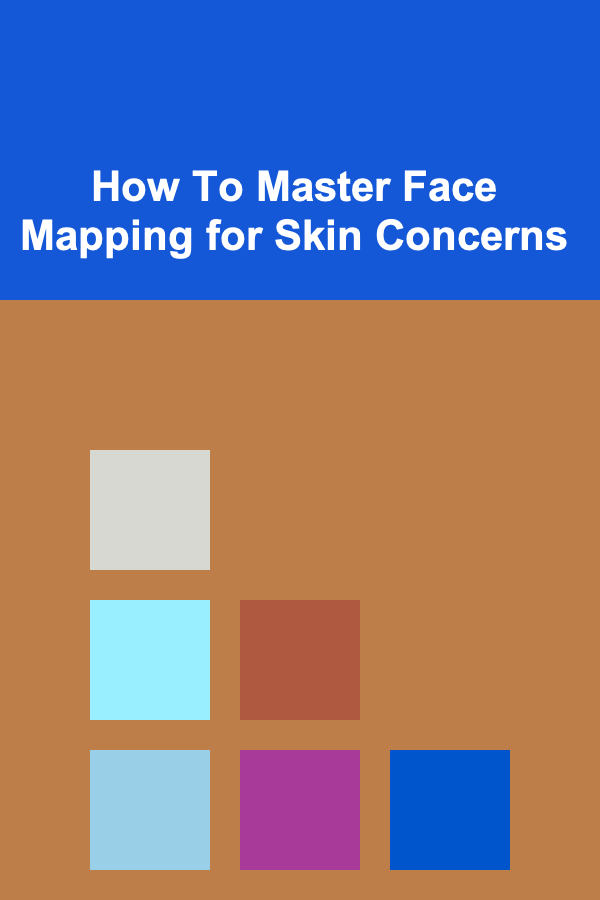
How To Master Face Mapping for Skin Concerns
ebook include PDF & Audio bundle (Micro Guide)
$12.99$7.99
Limited Time Offer! Order within the next:

Face mapping is a centuries-old technique rooted in traditional Chinese medicine (TCM) and Ayurveda that offers valuable insights into how your skin's health can reflect your internal health. It's the belief that different areas of your face correspond to different organs in your body. While face mapping may seem like a mystical practice at first glance, it's been widely adopted in the wellness and skincare industries for its potential to address skin concerns with a holistic approach.
In this comprehensive guide, we'll explore how face mapping works, its connection to both Eastern and Western medicine, and how you can use it to master your skincare routine and tackle common skin concerns.
What Is Face Mapping?
Face mapping divides the face into sections, each believed to correspond with specific organs or systems in the body. By analyzing breakouts, acne, redness, dryness, and other skin conditions in these areas, proponents of face mapping suggest that the skin can serve as a mirror to the body's internal health.
In many cultures, particularly in TCM, it's believed that the body's energy, known as "Qi," flows through channels (meridians), which can influence the skin. By looking at where issues appear on the face, practitioners can hypothesize which internal systems may be out of balance and need attention.
While modern dermatology doesn't always embrace face mapping in a medical sense, many people find it useful as an additional tool for identifying possible underlying health issues contributing to skin concerns.
Face Mapping Zones
The face can be divided into several key regions, each corresponding to particular parts of the body. Let's break down the common face mapping zones and the skin concerns that arise in each area.
Forehead: Digestive System and Stress
The forehead area is often linked to the digestive system, particularly the stomach and intestines. When breakouts appear on the forehead, they may signal digestive issues such as poor diet, constipation, or food intolerances. High-fat foods, dairy, or sugar may contribute to skin imbalances, showing up as pimples, cysts, or redness.
In addition to digestive concerns, the forehead can also be related to stress. Tension and anxiety can manifest as acne, particularly along the hairline or between the brows. This can occur due to increased cortisol production, a stress hormone, which leads to inflammation and clogged pores.
How to Address Forehead Concerns:
- Maintain a balanced diet with plenty of fiber to promote good digestion.
- Drink water regularly to keep your digestive system healthy.
- Manage stress through techniques like mindfulness, yoga, or deep breathing exercises.
- Use gentle, non-comedogenic skincare products that don't clog pores.
Between the Brows: Liver and Detoxification
The area between the brows, often referred to as the "third eye," is said to correspond to the liver. When breakouts appear in this area, it's often believed to signal a liver imbalance or toxin buildup. The liver plays a crucial role in detoxifying the body, so if it's under stress, whether from overconsumption of alcohol, toxins, or processed foods, the skin may react.
In traditional practices, skin concerns here may also relate to anger or frustration, emotions thought to influence liver health.
How to Address Between the Brows Concerns:
- Increase liver-supporting foods, such as leafy greens, beets, and citrus fruits.
- Cut back on alcohol and processed foods that can overload the liver.
- Incorporate detoxifying practices like fasting (under medical supervision) or herbal teas like dandelion root, which is known to support liver health.
- Practice emotional regulation to reduce stress and anger.
Temples: Hormones
Breakouts or skin concerns around the temples are often linked to hormonal changes or imbalances. Women, in particular, may experience breakouts around this area during their menstrual cycle or while undergoing hormonal shifts due to pregnancy, menopause, or the use of birth control.
The temples are also connected to the adrenal glands, which produce stress hormones. When under chronic stress, adrenal glands may secrete excess cortisol, leading to inflammation and acne.
How to Address Temple Concerns:
- Practice stress-reducing activities like exercise or meditation to regulate hormone levels.
- Consider tracking your hormonal cycles to identify specific times when breakouts occur, which can help guide treatment.
- Choose skincare that targets hormonal acne, often including ingredients like salicylic acid or benzoyl peroxide.
- Consider seeing a dermatologist to discuss options for hormonal imbalance treatments.
Cheeks: Lungs and Respiratory Health
The cheeks are believed to correspond with the lungs, and any skin issues that arise here might be connected to respiratory problems, allergies, or environmental factors. People who are exposed to pollution, smoke, or dust may notice breakouts on their cheeks as a result of clogged pores or irritation.
In addition, lifestyle habits like smoking or respiratory conditions like asthma can contribute to skin concerns in the cheek area. Some also believe that emotional stress linked to grief or sadness can trigger skin issues here, particularly on the left cheek.
How to Address Cheek Concerns:
- Improve air quality by investing in a good air purifier, especially if you live in a polluted area.
- Avoid smoking, and reduce exposure to secondhand smoke and other environmental toxins.
- Use gentle skincare products to avoid irritating the skin, especially if you have sensitive skin.
- Incorporate breathing exercises or techniques to improve lung health and reduce stress.
Nose: Heart and Circulation
The nose is often linked to the heart and circulatory system. Breakouts on the nose can sometimes indicate blood pressure issues or circulatory problems, as poor circulation can impact the skin's health and lead to congestion. Additionally, skin concerns on the nose can be connected to poor dietary habits, particularly an excess of sugar or dairy.
The nose area may also be connected to the body's stress response, particularly in cases where blood pressure rises.
How to Address Nose Concerns:
- Adopt a heart-healthy diet rich in omega-3 fatty acids, antioxidants, and whole foods.
- Consider getting regular exercise to improve blood circulation and overall health.
- Avoid excess sugar and dairy, which are common triggers for acne in this area.
- Incorporate relaxation techniques to manage stress and improve heart health.
Chin: Reproductive System and Hormonal Imbalance
The chin and jawline are strongly associated with hormonal fluctuations, particularly those tied to the reproductive system. Women often experience breakouts in this area during menstruation, pregnancy, or menopause due to hormonal shifts. If breakouts persist around the chin, it may indicate an imbalance in androgen hormones, which play a role in acne formation.
Acne in this region is common in women suffering from polycystic ovary syndrome (PCOS) or other endocrine-related conditions.
How to Address Chin Concerns:
- Speak with a healthcare provider to address any hormonal imbalances that may be contributing to acne.
- Try acne treatments targeting hormonal breakouts, including topical retinoids or oral contraceptives (under medical guidance).
- Maintain a balanced diet that supports hormonal health, including adequate protein and healthy fats.
- Practice stress management, as stress can exacerbate hormonal imbalances.
Jawline: Digestive and Hormonal Factors
The jawline, much like the chin, is closely tied to hormonal fluctuations. However, jawline acne can also be associated with digestive concerns, particularly when the gut microbiome is out of balance. Clogged pores due to poor digestion, along with food sensitivities, may manifest as painful cystic acne along the jawline.
Additionally, when the body's hormonal balance is out of whack, whether from stress, diet, or lifestyle, this area can also become a hotspot for breakouts.
How to Address Jawline Concerns:
- Focus on improving digestion by incorporating probiotics, prebiotics, and fiber-rich foods into your diet.
- Experiment with an elimination diet to identify any food triggers that might be affecting your skin.
- Take care of your digestive health by staying hydrated and avoiding overly processed foods.
- Manage stress levels to keep cortisol production in check, especially in the face of hormonal shifts.
Under the Eyes: Kidney Health
The skin under your eyes is delicate and sensitive, and its condition can be an indicator of kidney health. Dark circles or puffiness can signal dehydration, stress, or kidney-related issues. The kidneys play a key role in detoxification, so when they are overburdened, fluid retention or toxin buildup may affect the skin beneath the eyes.
How to Address Under-Eye Concerns:
- Stay hydrated to support kidney function and reduce puffiness under the eyes.
- Use cooling eye creams containing ingredients like caffeine or chamomile to reduce swelling.
- Consider improving your kidney health with foods such as cranberries, leafy greens, and hydration.
- Ensure you get adequate sleep, as tiredness and stress can contribute to dark circles.
How To Implement Face Mapping into Your Skincare Routine
Understanding the relationship between internal health and external skin appearance is the first step in mastering face mapping. By analyzing the patterns of your skin concerns, you can adopt a more targeted approach to skincare. Here's how you can incorporate face mapping into your routine:
- Track Your Skin: Keep a skincare journal to note any changes in your skin's appearance and the specific areas where breakouts or irritation occur.
- Identify Underlying Issues: Pay attention to the patterns of breakouts and consider any internal factors such as diet, lifestyle, stress, or hormonal fluctuations.
- Consult with a Professional: While face mapping can provide valuable insights, consulting with a dermatologist, nutritionist, or healthcare provider is essential to address deeper issues.
- Adopt a Holistic Approach: Along with targeted skincare treatments, consider improving your internal health by adjusting your diet, reducing stress, and prioritizing physical and emotional well-being.
- Personalized Skincare: Based on the face mapping zones and any identified concerns, select skincare products that address your specific needs. For instance, incorporate products designed for hormonal acne, digestive health, or stress relief.
Conclusion
Face mapping offers a unique and holistic approach to understanding the skin's connection to overall health. By identifying the underlying causes of breakouts or skin irritation in different zones of the face, you can gain deeper insights into the functioning of your body's systems. Combining face mapping with personalized skincare routines, stress management, and lifestyle changes can lead to healthier, clearer skin. Whether you seek to address acne, dryness, or other skin concerns, mastering face mapping can be an essential tool in your skincare arsenal.
Reading More From Our Other Websites
- [Organization Tip 101] How to Use Clear Containers for Small DIY Parts
- [Organization Tip 101] How to Use Folding Tables for Flexible Garage Space
- [Personal Care Tips 101] How to Know When It's Time to Switch Your Facial Cleanser for Better Skin Health
- [Toy Making Tip 101] Best Ways to Repurpose Recycled Plastic Bottles into Fun Building Block Sets
- [Home Space Saving 101] How to Optimize Your Laundry Room for Space Efficiency
- [Home Storage Solution 101] How to Organize Your Closet for Easy Access to Everyday Items
- [Sewing Tip 101] Hidden Zippers Made Easy: Seamless Finishing Techniques
- [Home Budget Decorating 101] How to Redesign Your Home Using Only Affordable Fabrics
- [Personal Investment 101] How to Avoid Common Investment Mistakes That Can Hurt Your Wealth
- [Home Security 101] How to Secure Your Home Against Seasonal Threats like Storms and Flooding

Coping with Job Search Burnout: Self-Care Strategies
Read More
How To Draw Historical Figures with Accuracy
Read More
How to Save Money with Simple DIY Car Maintenance Tasks
Read More
How To Host a Successful Board Game Night
Read More
Cultivating a Sense of Belonging: Weaving Connection in a Fragmented World
Read More
How to Grocery Shop with ADHD: A Detailed To-Do List
Read MoreOther Products

Coping with Job Search Burnout: Self-Care Strategies
Read More
How To Draw Historical Figures with Accuracy
Read More
How to Save Money with Simple DIY Car Maintenance Tasks
Read More
How To Host a Successful Board Game Night
Read More
Cultivating a Sense of Belonging: Weaving Connection in a Fragmented World
Read More